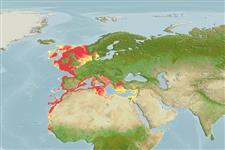Classification / Names
Common names from other countries
Main reference
Size / Weight / Age
Max length : 100.0 cm TL male/unsexed; (Ref. 244); common length : 60.0 cm TL male/unsexed; (Ref. 4645); max. published weight: 1.3 kg (Ref. 40637); max. reported age: 12 years (Ref. 81067)
Length at first maturity
Lm 57.0, range 41 - 64 cm
Environment
Marine; demersal; depth range 10 - 780 m (Ref. 56504), usually 80 - 100 m (Ref. 81056)
Climate / Range
Subtropical, preferred 21°C (Ref. 107945); 63°N - 12°N, 18°W - 36°E
Distribution
Northeast Atlantic: Norway and British Isles south to Senegal, including the Mediterranean. Possibly Côte d'Ivoire. Some populational differences exist between Catulus duhameli (a name for the Mediterranean canicula based on size) and this species which may eventually be expressed as subspecies. The only reported observation of this species in Crimean waters was in 1937, which is possibly erroneous (Ref. 897).
Countries | FAO areas | Ecosystems | Occurrences | Introductions
Short description
Dorsal
spines
(total): 0;
Dorsal
soft rays
(total): 0;
Anal
spines: 0;
Anal
soft rays: 0. A slender, dark-spotted catshark with 8-9 dusky saddles (often obscure or absent), greatly expanded anterior nasal flaps, reaching mouth and covering shallow nasoral grooves, labial furrows on lower jaw only, first dorsal fin originates well behind the pelvic fins, second dorsal fin much smaller than first (Ref. 244).
IUCN Red List Status (Ref. 115185)
Threat to humans
Harmless
Human uses
Fisheries: minor commercial
More information
ReferencesAquacultureAquaculture profileStrainsGeneticsAllele frequenciesHeritabilityDiseasesProcessingMass conversion
Tools
Special reports
Download XML
Internet sources
Estimates of some properties based on models
Phylogenetic diversity index
PD50 = 0.5000 many relatives (e.g. carps) 0.5 - 2.0 few relatives (e.g. lungfishes)
Trophic Level
3.8 ±0.3 se; Based on diet studies.
Resilience
Low, minimum population doubling time 4.5 - 14 years (K=0.20; tm=9; Fec=96)
Vulnerability
High vulnerability (62 of 100)
Price category
